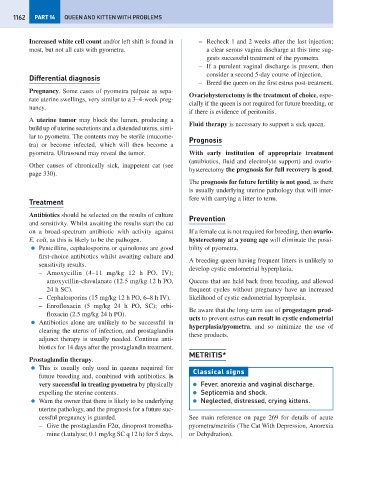Page 1170 - Problem-Based Feline Medicine
P. 1170
1162 PART 14 QUEEN AND KITTEN WITH PROBLEMS
Increased white cell count and/or left shift is found in – Recheck 1 and 2 weeks after the last injection;
most, but not all cats with pyometra. a clear serous vagina discharge at this time sug-
gests successful treatment of the pyometra.
– If a purulent vaginal discharge is present, then
consider a second 5-day course of injection.
Differential diagnosis
– Breed the queen on the first estrus post-treatment.
Pregnancy. Some cases of pyometra palpate as sepa-
Ovariohysterectomy is the treatment of choice, espe-
rate uterine swellings, very similar to a 3–4-week preg-
cially if the queen is not required for future breeding, or
nancy.
if there is evidence of peritonitis.
A uterine tumor may block the lumen, producing a
Fluid therapy is necessary to support a sick queen.
build up of uterine secretions and a distended uterus, simi-
lar to pyometra. The contents may be sterile (mucome-
Prognosis
tra) or become infected, which will then become a
pyometra. Ultrasound may reveal the tumor. With early institution of appropriate treatment
(antibiotics, fluid and electrolyte support) and ovario-
Other causes of chronically sick, inappetent cat (see
hysterectomy the prognosis for full recovery is good.
page 330).
The prognosis for future fertility is not good, as there
is usually underlying uterine pathology that will inter-
fere with carrying a litter to term.
Treatment
Antibiotics should be selected on the results of culture
Prevention
and sensitivity. Whilst awaiting the results start the cat
on a broad-spectrum antibiotic with activity against If a female cat is not required for breeding, then ovario-
E. coli, as this is likely to be the pathogen. hysterectomy at a young age will eliminate the possi-
● Penicillins, cephalosporins or quinolones are good bility of pyometra.
first-choice antibiotics whilst awaiting culture and
A breeding queen having frequent litters is unlikely to
sensitivity results.
develop cystic endometrial hyperplasia.
– Amoxycillin (4–11 mg/kg 12 h PO, IV);
amoxycillin-clavulanate (12.5 mg/kg 12 h PO, Queens that are held back from breeding, and allowed
24 h SC). frequent cycles without pregnancy have an increased
– Cephalosporins (15 mg/kg 12 h PO, 6–8 h IV). likelihood of cystic endometrial hyperplasia.
– Enrofloxacin (5 mg/kg 24 h PO, SC); orbi-
Be aware that the long-term use of progestagen prod-
floxacin (2.5 mg/kg 24 h PO).
ucts to prevent estrus can result in cystic endometrial
● Antibiotics alone are unlikely to be successful in
hyperplasia/pyometra, and so minimize the use of
clearing the uterus of infection, and prostaglandin
these products.
adjunct therapy is usually needed. Continue anti-
biotics for 14 days after the prostaglandin treatment.
METRITIS*
Prostaglandin therapy.
● This is usually only used in queens required for
Classical signs
future breeding and, combined with antibiotics, is
very successful in treating pyometra by physically ● Fever, anorexia and vaginal discharge.
expelling the uterine contents. ● Septicemia and shock.
● Warn the owner that there is likely to be underlying ● Neglected, distressed, crying kittens.
uterine pathology, and the prognosis for a future suc-
cessful pregnancy is guarded. See main reference on page 269 for details of acute
– Give the prostaglandin F2α, dinoprost trometha- pyometra/metritis (The Cat With Depression, Anorexia
mine (Lutalyse; 0.1 mg/kg SC q 12 h) for 5 days. or Dehydration).

